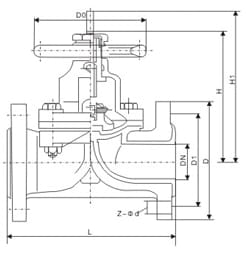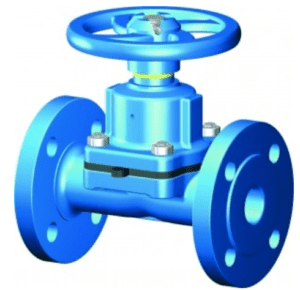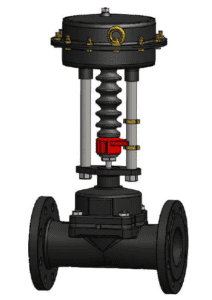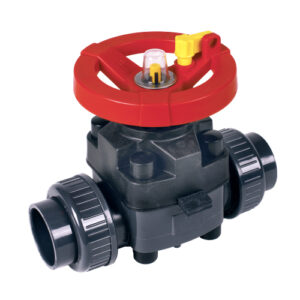Straight Through Diaphragm Valve
Straight Through Diaphragm Valve
NTGD Valve is professional straight through diaphragm valve manufacturer. Feel free to contact us if you have any inquiry
What is a straight-through diaphragm valve?

This is a diaphragm valve designed with a straight flow passage. Unlike other diaphragm valves, this valve does not have a raised weir. This design leads to a full-bore valve that enhances excellent performance at the low-pressure drop. Straight-through diaphragm valve manufacturers recommend using this valve for applications prone to dirt, powder, and contaminated media. This is because such media would hardly be clogged in the valve due to the straight nature of the fluid passage. This type of valve is driven manually via a handwheel or by use of actuators. The choice operation (manual or automatic) depends on several factors among them customer preference. Straight-through diaphragm valves work by moving a diaphragm up or down to start or stop fluid flow. The diaphragm is usually connected to the handwheel or actuator via a component known as stem. This valve is versatile as it can be used in different applications including water supply, foods and beverages, chemical processing, fire hydrants, and petrochemicals among others.
Components of a straight-through diaphragm valve
Handwheel
The handwheel is the component of a straight-through diaphragm valve used by the valve operator to apply force to start or stop fluid flow. The handwheel is used in manual valves.
Actuator
The actuator is a component used in automatic straight-through diaphragm valves to provide the force needed to start or stop fluid flow. Straight-through diaphragm valve manufacturers design the actuator so that it can operate the valve automatically.
Stem
The stem in a straight-through diaphragm valve is a threaded shaft component that has its top end connected to the bottom of the handwheel. The work of the stem is to transmit force or torque applied on the handwheel to the component of the valve that stops and starts the fluid flow. The stem rotates as it moves up or down depending on the direction of rotation of the handwheel/actuator. The stem can be rising or non-rising. The rising stem is used to help the operator easily know when opening/closing the valve. This stem extends past the handwheel when the valve is opened. The non-rising stem does not extend past the handwheel when the valve is opened.
Compressor
The compressor is a component connected to the bottom end of the stem. The compressor is meant to act on the diaphragm to either block or allow fluid flow. The compressor gets the power to act on the diaphragm from the actuator/handwheel through the stem.
Diaphragm
This is the component that is tasked with opening and closing fluid flow through the straight-through diaphragm valve. The diaphragm is connected to the compressor and this compressor provides power for the diaphragm to operate.
Valve body
This is the component of a straight-through diaphragm valve that houses internal components of the valve like the diaphragm and seals. The valve body is made of metallic materials that can guarantee high strength to the valve relative to the fluid pressure.
Bonnet
Bonnet is another component of the valve body but it is placed on top of the valve body. The bonnet is meant to house non-wetted parts of the valve like the compressor and stem. Bonnet and body are made of the same material.
Gasket
This component is placed between the body and the bonnet to prevent fluid leakage. It is also placed between the body and pipe joint to prevent fluid leakage.

How does a straight-through diaphragm valve work?
Straight through diaphragm valves operates by employing vertical linear motion on the diaphragm. This motion is usually initiated by the handwheel or actuator depending on whether the valve is manual or automatic. To open the valve, the operator rotates the handwheel in the clockwise direction. This forces the stem to make similar rotation as it moves upwards. The stem is connected to the compressor and the compressor is connected to the diaphragm. Therefore, any upward movement of the stem and compressor forces the diaphragm to move upwards leaving the valve open for fluid flow. To stop the fluid flow, the handwheel is rotated in the anticlockwise direction forcing the stem and compressor to move linearly downwards. This downward motion forces the diaphragm to the bottom of the valve body cutting any fluid flow through the valve. Straight-through diaphragm valve manufacturers produce this valve for use in on and off as well as throttling application. For throttling flow, the handwheel is rotated to some degree. This forces the diaphragm to slightly open allowing some amount of fluid to pass through the valve.

Types of straight-through diaphragm valves
Manual straight-through diaphragm valve
This is the straight-through diaphragm valve which is operated by use of manual means such as a handwheel or hand lever. The work of the handwheel or hand lever is to stop and start fluid flow as well as throttling. Straight-through diaphragm valve manufacturers make the diaphragm of this valve from elastomeric or another flexible material. This helps to make the diaphragm push against the flexible elastomeric material until it meets the bottom-most part of the valve body pinching fluid flow closed. Straight-through diaphragm valve manufacturers include indicators on this valve to help show the operator when the valve is opened or closed. One of the indicators is by use of a rising stem that goes above the handwheel when the valve is open. Another method is by use of a non-rising stem which does not go above the handwheel but has indicators that help the operator know whether the valve is fully open or closed. One advantage of manual straight-through diaphragm valves is that they are cheaper relative to manual types. However, for high torque and frequent operation, they tend to be tedious to operate.
Figure: Manual straight-through diaphragm valve.
Automatic straight-through diaphragm valve
This is the version of a straight-through diaphragm valve that is operated by use of an actuator. This type of valve is either semi-automatic or fully automatic. This type of valve is advantageous in that it reduces the cost of hiring a valve operator. It also enhances safety especially where the media controlled is hazardous or corrosive unlike in manual types in which any slight leakage can affect the operator while starting or stopping the valve. There are three types of valves under this category that is pneumatic type, electric type, and hydraulic type.
Pneumatic straight-through diaphragm valve
This is the type of automatic straight-through diaphragm valve that operates by using a pneumatic actuator. This actuator operates by using compressed air or gas. The actuator consists of one or two chambers where the air is compressed. The compressed air acts on a piston component which then forces the valve stem and thus the diaphragm to move up or downwards. This type of valve is suitable for use in hygienic applications since the air used in the actuator can be filtered to remove dirt unlike hydraulic valve types.
Electric straight-through diaphragm valve
This is the automatic straight-through diaphragm valve which is operated by the use of an electric actuator. This actuator is connected to the electricity main supply which makes this valve operable only when there is electricity. The electrical energy is converted by mechanical systems into mechanical energy. The mechanical energy is then used to rotate the valve stem and thus the diaphragm can move up or down to start or stop fluid flow respectively.
Figure: Electric straight-through diaphragm valve.
Hydraulic straight-through diaphragm valve
This is an automatic straight-through diaphragm valve that is operated by the use of a hydraulic actuator. As the name suggests, this valve actuator uses hydraulic fluid. This type of valve is very powerful because of the incompressibility property of hydraulic fluids. As such, straight-through diaphragm valve manufacturers design this valve for use where high torque is required. Because of dirt associated with hydraulic systems, this valve is recommended for use in applications that do not need high levels of hygiene like corrosives, mining, paper and pulp among others.
Plastic straight-through diaphragm valve
This is the version of a straight-through diaphragm valve that is made of plastic material. This type of valve is very reliable in controlling flow of corrosive media as it is highly resistant to corrosion. However, straight-through diaphragm valve manufacturers recommend use of this valve only in low-temperature applications in which the temperature is below 60oC due to the low melting properties of plastic materials. Plastic straight-through diaphragm valves are cheaper to manufacture relative to metallic ones. Also, these valves are of low weight compared to metallic ones due to the low density of plastics.
Figure: Plastic straight-through diaphragm valve.
Applications of straight-through diaphragm valves
- Straight-through diaphragm valves are used in brewery processing plants.
- They are used in chemical processing plants.
- They are used in food processing plants.
- Straight-through diaphragm valves are used in water supply and wastewater treatment.
- They are used in vacuum services.
- These valves are used in pharmaceutical manufacturing plants.
- They are used in heating, ventilation, and air-conditioning (HVAC) systems.
- They are used in oil and gas refinery systems.
- These valves are used in paper and pulp manufacturing plants.
- They are used to control flow of water in firefighting systems.
Advantages of straight-through diaphragm valves
- Straight-through diaphragm valves do not have weirs which makes them free from blockage, unlike the weir types.
- These valves are bi-directional which allows fluid flow in either direction of the pipe.
- They are free from fluid leakage.
- Straight-through diaphragm valves are used in slurries and very viscous fluids.
- These valves are versatile as they can be used in wide areas of industrial applications.
- These valves are resistant to corrosion.
- Straight-through diaphragm valves are easy to install, clean, repair and do maintenance.
- They are simple and compact in design.
- They can operate under a wide range of pressure levels.
Disadvantages of straight-through diaphragm valves
- The diaphragm in these valves tends to wear rapidly when used in heavy throttling.
- These valves are suitable for use only in moderate pressure and temperatures.
- The diaphragm has to be replaced frequently unlike in weir type diaphragm valves.
Troubleshooting straight through diaphragm valves
Leakage through the stem
- Damaged diaphragm. Replace the diaphragm.
- Damaged or worn-out seals. Replace the seals.
Leakage through the valve body
- Damaged valve body. Replace the body.
Leakage through the pipe-body connection
- Worn out gaskets. Replace the gaskets.
- Loose bolts and nuts. Tighten the bolts and nuts to the torque mentioned by the straight-through diaphragm valve manufacturer.
- Excess fluid pressure. Operate the valve at recommended pressure.
Ruptured diaphragm
- Excessive opening height. Do not exceed the opening height.
- Excess operating pressure. Do not exceed the recommended operating pressure.
- Foreign materials clogged the valve. Open the valve and clean off the materials.
- Aged diaphragm valve. Replace the diaphragm.
The valve is hard to operate
- Damaged stem. Replace the stem.
- Dirt clogged between the bonnet and stem. Clean off the dirt.
Summary
Straight through diaphragm valve is a type of valve which has its body straight without a raised lip. This type of valve is suitable for use in applications that involve viscous fluids and slurries as it hardly gets blocked. This type of valve operates either manually or automatically by using a handwheel or actuator respectively. Despite being manual or automatic, the working principle is the same. The operation starts when the handwheel/actuator rotates the stem forcing the valve diaphragm to move up or down to start or stop fluid flow respectively.
Straight-through diaphragm valve manufacturers produce various types of this valve which include manual straight-through diaphragm valves, automatic straight-through diaphragm valves, and plastic straight-through diaphragm valves among others. The automatic versions of these valves include pneumatic, electric, and hydraulic straight-through diaphragm valves. Applications of these valves include oil refinery, water supply, foods and beverages, paper and pulp, chemical processing, and fire fighting among others. The advantages of using straight-through diaphragm valves are bi-directional flow, versatility, zero leakage, easy to clean, repair, and do maintenance, compact and simple design.



